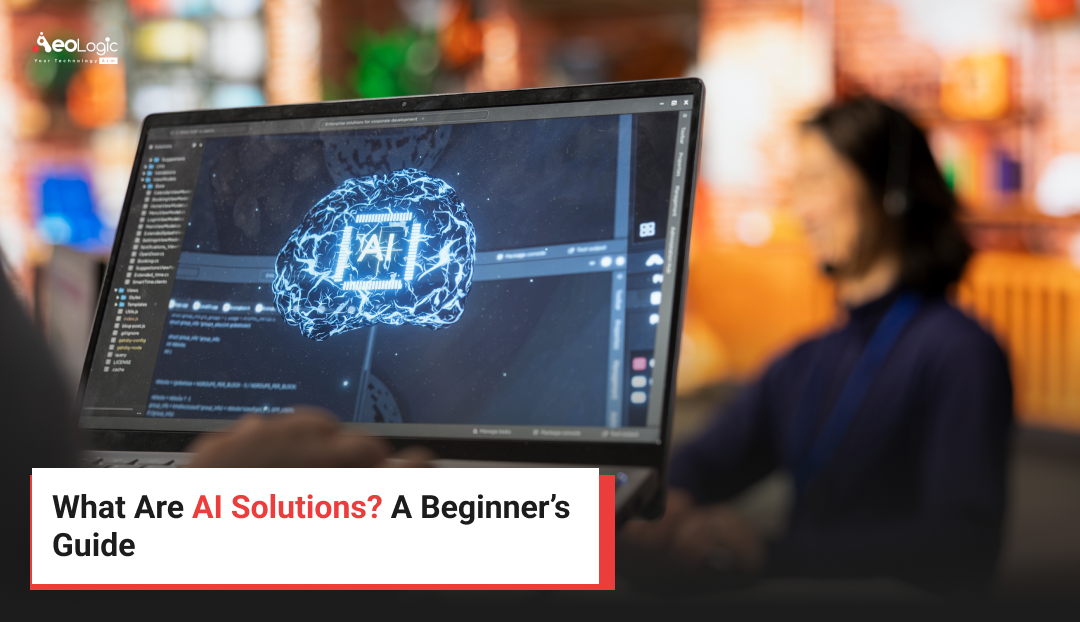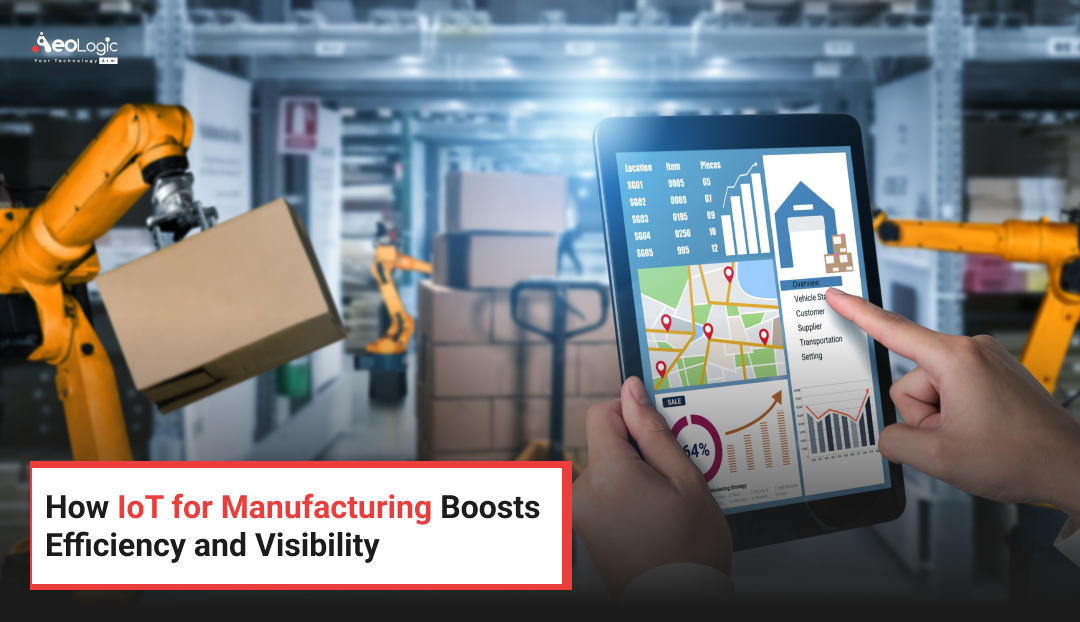These days, it feels like everywhere you go, someone is talking about AI solutions. You open YouTube, and you see videos about how AI is changing jobs. You scroll on LinkedIn, and every company is sharing posts about using AI tools. It’s all around us. But if you really stop and think, most people don’t clearly understand what AI actually means; they’ve just heard the word so many times that it feels like they do.
That’s exactly what happened to me too, when I first started reading about AI. It sounded very technical and complicated like something only computer scientists or engineers could understand. But when I looked deeper, I realized it’s not that scary. In fact, we use AI solutions every single day without even knowing it.
When your phone unlocks by looking at your face, when Spotify suggests songs you might like, when Google Maps shows the shortest route all of that is powered by AI. So, what we call “AI” isn’t just one thing. It’s a bunch of smart systems that learn from data and help make things easier or faster for people and businesses.
In this blog, I’ll try to explain in plain and simple words what are AI solutions, how they work, what types exist, and how they’re used. I’m not an expert, just someone who reads a lot and tries to explain things in an easy way. So, if you’re someone who finds all this “AI talk” confusing, this post is written exactly for you.
What Are AI Solutions?
To keep it really simple, AI solutions are smart systems or tools that use artificial intelligence to solve real-life problems. You can think of them like assistants that can analyze data, learn from it, and then make decisions automatically — just like humans do, but faster.
For example:
-
When a website uses a chatbot to talk to customers automatically — that’s an AI solution.
-
When a company uses software that predicts which product will sell more next month — that’s also an AI solution.
-
Even when you type something in Google and it “guesses” what you’re going to type next — that’s AI at work.
So basically, AI solutions are everywhere around us. They can be in your phone, in your office software, in hospitals, in factories, and even in farming machines.
The main thing that makes them “AI” is that they can think, learn, and improve with time — they don’t need to be told what to do every single time. They understand patterns and use logic to take action.
If we go by the proper definition, AI stands for Artificial Intelligence, which means machines or software that can imitate human thinking — like learning, problem-solving, planning, and reasoning. But to keep it less technical, you can just say AI is “smart technology that learns on its own.”
Why AI Solutions Are So Popular Now
The reason AI has become such a big topic today is because of data and computing power. A few years ago, computers weren’t fast enough and data was limited. But now, everything we do online — from browsing websites to shopping to watching videos — creates massive amounts of data.
This data helps AI systems learn better. Combine that with faster computers and better algorithms, and suddenly, AI became something every business wanted to use.
Also, AI makes life easier. Imagine you own a small online shop. Instead of manually checking which product people like the most, AI can show you that automatically. It can also reply to customer questions while you sleep, or remind you to restock items before they sell out. That’s how powerful it is.
AI solutions are helping not only big companies but also small startups and even freelancers. It’s becoming like electricity — invisible but running everything behind the scenes.
How AI Works in Simple Words
The easiest way to understand how AI works is to think of it like a human brain — it learns by seeing examples.
For example, if you show a child 100 pictures of cats, they’ll slowly learn what a cat looks like. The next time they see a new picture, they can say, “Hey, that’s a cat!”
AI works exactly the same way. Instead of pictures, it gets data — thousands or millions of examples. It studies them, finds patterns, and then uses that knowledge to make decisions.
The process usually goes like this:
-
Collect data — The system gathers lots of examples.
-
Train the model — It learns patterns from the data.
-
Make predictions — It starts guessing or deciding based on what it learned.
-
Improve with time — The more it practices, the better it gets.
That’s why you might notice that AI tools like voice assistants get smarter the more you use them — they’re learning from your habits.
Main Parts of AI Solutions
When I started reading about AI, I thought it was just one big computer doing everything. But later, I found out that AI systems are made up of many small parts that work together like a team. Each part has its own job, and together they make the system smart.
Here are the main parts of most AI solutions, explained simply:
Data
This is where everything starts. AI needs data to learn — it’s like the food for AI. The more data it has, the better it can learn and perform. For example, if you want to make an AI that recognizes fruits, you need to give it hundreds or thousands of pictures of fruits. Without data, AI is just empty — it cannot guess anything.
Algorithms
An algorithm is like a recipe that tells the computer what steps to take. It teaches the AI how to look at the data and how to find patterns. There are many types of algorithms — some are simple, and some are very advanced.
Machine Learning Models
This is the “brain” of AI. It’s the part that learns from data and makes decisions. After it studies enough examples, it starts predicting results on its own. For example, after learning from thousands of medical scans, a model can start identifying diseases automatically.
Training Process
This is where AI actually learns. It takes data, tests itself, makes mistakes, and improves over time — just like how humans learn from practice.
Hardware and Software
AI needs powerful computers and software to work. For example, cloud platforms like Google Cloud, AWS, or Microsoft Azure are used by companies to train AI because they can handle large data easily.
Human Input
Even though AI is smart, humans still play a role. People tell it what to learn, check if it’s working properly, and make improvements when needed.
Types of AI Solutions
AI is not just one kind of system. There are many types depending on what they do and how smart they are. Let’s break it down in the easiest way possible:
Rule-Based AI
This type follows fixed rules written by humans. It’s simple and predictable. Example — chatbots that answer FAQs with pre-written answers.
Machine Learning (ML) AI
This one learns from data instead of fixed rules. The more examples it sees, the smarter it gets. For example, spam filters in Gmail learn which messages are spam based on what users mark as spam.
Deep Learning AI
This is a more advanced form of machine learning. It uses “neural networks,” which are inspired by how our brain works. This type is used in self-driving cars and image recognition systems.
Natural Language Processing (NLP)
This AI can understand and talk like humans. It powers things like Siri, Alexa, and even the chatbots you see on websites.
Computer Vision AI
This AI can see and understand pictures or videos. It’s used in CCTV cameras, factories, hospitals, and even social media filters.
Predictive AI
This AI tries to guess what will happen next. Businesses use it for things like predicting sales, customer behavior, or even weather conditions.
Real-Life Examples of AI Solutions
Now, this is the fun part — where we can see how AI is used in real life. You’ll realize that we actually use AI every single day without even noticing.
Voice Assistants
When you say “Hey Siri” or “Okay Google,” that’s AI listening and understanding your voice. It finds the right answer and replies instantly.
Recommendation Systems
Netflix showing “Top Picks for You,” YouTube suggesting videos, or Amazon showing “People also bought” — all of that is AI guessing what you might like.
Healthcare AI
Hospitals use AI tools to detect diseases early, read X-rays, and even suggest treatments based on patient history.
Finance and Banking
AI checks for fake transactions, analyzes loan applications, and even helps traders make better financial decisions.
Education
AI tools personalize lessons for students based on their learning speed. Teachers also use it to check assignments faster.
Transportation
Self-driving cars and AI-powered traffic lights are slowly becoming common. These use sensors, data, and AI to make travel safer and faster.
Marketing and Business
AI helps in creating ads, analyzing customer data, and even predicting what kind of product people will buy next.
Benefits of AI Solutions
AI is growing fast because it makes life easier, business smarter, and work faster. When I first started learning about it, I thought it was only for big companies. But now I can see that even small teams and regular people use AI tools daily without realizing it.
Here are the main benefits of AI solutions written in the simplest way possible.
Saves Time
AI can do boring and repetitive tasks in seconds. For example, checking thousands of records, replying to emails, or processing data that would take humans hours.
Works 24/7
Unlike humans, AI never sleeps or gets tired. It can keep running all day and night without breaks, which is great for customer service and online support.
More Accurate
AI doesn’t forget steps or lose focus. It follows the same logic every time, so mistakes are reduced. Hospitals, for example, use AI because it gives accurate results while reading reports.
Cost-Effective
At the start, AI setup might look expensive, but once it’s running, it saves a lot of money by reducing manual work.
Better Decisions
AI can read huge amounts of data and quickly find what’s important. It helps managers take smarter decisions with facts instead of guesses.
Predicts the Future
One of the coolest parts of AI is prediction. Businesses use AI to guess future sales, demand, or trends by studying past data.
Personalized Experience
Ever noticed how Netflix shows movies you like or how online stores suggest similar products? That’s AI giving you a personal experience.
Safety and Security
AI helps detect fraud in banks and keeps systems safe by tracking unusual activity in real time.
Consistency
AI gives the same result every time. There’s no mood swing or tiredness involved — it just keeps working exactly the same way.
Challenges of AI Solutions
Even though AI sounds amazing, it’s not perfect. There are still some real problems companies face when they try to use it.
High Cost of Development
Creating an AI system requires data, software, and technical people — all of which cost money.
Data Privacy Issues
AI needs data to learn. But when that data includes personal or private information, there’s a risk if it’s not handled properly.
Need for Skilled People
AI systems are not “plug and play.” They need people who know how to train, test, and manage them. Many small companies struggle with this.
Bias and Fairness
If AI learns from bad or unbalanced data, it can make unfair or wrong decisions. That’s why companies must use clean and neutral data.
Job Fear
Some workers worry that AI might take their jobs. It’s true that automation can replace a few tasks, but it also creates new jobs for people who manage and improve these systems.
Dependence on Technology
If the system fails or internet stops working, everything depending on AI can stop too.
Lack of Understanding
Many business owners want to use AI because it sounds cool, but they don’t actually know how it fits into their work — this leads to confusion and wasted money.
Industries That Use AI Solutions
AI isn’t limited to computers or robots anymore. It’s used almost everywhere. Here are some examples that show how common it has become.
Healthcare
Hospitals use AI to read X-rays, detect diseases early, and manage patient data safely. Some AI systems even help design new medicines.
Retail and E-Commerce
AI helps stores track stock, suggest products, and improve customer experience. Online shops like Amazon or Flipkart rely heavily on AI.
Banking and Finance
Banks use AI to stop fraud, approve loans faster, and understand customers’ spending habits.
Education
AI tools help teachers grade faster and create personalized lessons for students who need extra help.
Manufacturing
Factories use AI robots for assembly, packing, and maintenance. It helps prevent machine breakdowns before they happen.
Agriculture
Farmers use AI sensors to monitor soil, predict weather, and decide the best time for planting or harvesting crops.
Marketing
AI studies how people behave online and helps businesses show better ads and offers to the right audience.
Transportation
Self-driving cars and AI-controlled traffic lights are slowly becoming part of daily life.
Cybersecurity
AI systems can catch hacking attempts faster than humans by noticing strange patterns in data.
Energy and Utilities
Power companies use AI to predict energy demand, manage renewable energy, and reduce waste.
The Future of AI Solutions
The future of AI looks super exciting and a little scary at the same time. When I first started learning about AI, I thought it was only for tech companies. But now, AI is moving into every field you can think of — schools, farms, hospitals, even traffic systems. It’s not slowing down; it’s growing faster every year.
Here are some ways AI will change things in the future:
Smarter AI That Thinks Like Us
Right now, AI can follow patterns and make decisions, but in the future, it’ll understand emotions better too. Imagine talking to a computer that knows if you’re sad or happy — that’s the kind of AI researchers are building.
AI in Small Businesses
Before, only big companies could afford AI systems. But in the future, even small shops and startups will use AI tools for marketing, accounting, and customer service.
Better AI Security
One of the biggest challenges today is data safety. The next generation of AI systems will be safer, fairer, and more transparent — so people can trust them more.
AI and Internet of Things (IoT)
Soon, AI will connect with everything — phones, cars, homes, even refrigerators. They’ll talk to each other and make daily life smoother. For example, your fridge could remind you when milk is about to finish.
AI in Healthcare and Education
Doctors will use AI to find diseases faster, and schools will use AI tutors that help students personally. It’ll make learning and healthcare more available for everyone.
New Jobs and Skills
Many people fear AI will take jobs, but new jobs will also come up. We’ll need people who can manage, teach, and improve AI systems. The world will need more AI experts, data analysts, and designers than ever before.
So, the future of AI isn’t about replacing humans — it’s about helping us do more, faster, and smarter.
Frequently Asked Questions (FAQs)
1. What does AI actually mean?
AI stands for Artificial Intelligence, which means machines or software that can think, learn, and make decisions like humans.
2. What are AI solutions used for?
AI solutions help businesses and people save time, reduce mistakes, and make smarter decisions — from chatbots to medical diagnosis tools.
3. What are some examples of AI in daily life?
Voice assistants like Siri or Alexa, YouTube video recommendations, and even your phone’s face unlock feature — all are examples of AI.
4. Is AI dangerous?
AI itself isn’t dangerous, but if people use it the wrong way or train it with bad data, it can create problems. That’s why experts are working on “ethical AI.”
5. Can AI take my job?
AI might replace some repetitive jobs, but it also creates new jobs that need human creativity and decision-making. It’s more of a helper than a threat.
6. Is AI expensive to use?
At first, it can be costly for big setups, but now many affordable cloud-based AI tools are available for small businesses and individuals too.
7. How does AI learn new things?
AI learns from data. The more data it gets, the smarter it becomes. It studies patterns and uses them to make predictions or choices.
8. What’s the future of AI?
AI will be everywhere — in homes, offices, cars, hospitals, and schools. It’ll become more personal, safer, and much easier for everyone to use.
Conclusion
Now that we’ve gone through everything, we can easily understand what are AI solutions and why they are such a big deal in today’s world.
AI isn’t just some fancy term used by tech people — it’s something we already use in small ways every day. Whether it’s our phone helping us unlock with a face scan, our emails automatically sorting themselves, or our favorite apps suggesting the perfect content, AI is quietly doing its job in the background.
AI solutions make work faster, smarter, and more accurate. They help people focus on creativity while machines handle repetitive tasks. Yes, AI has some challenges — like cost, data privacy, and trust — but as technology grows, these problems are slowly being solved.
In the next few years, AI will become even more common. Every industry will depend on it in some way. But the most important thing to remember is this — AI is a tool. It’s not here to replace humans but to help us achieve more.
So, the next time you hear the word AI, don’t imagine robots taking over. Think of it as a smart assistant quietly helping us every single day — from typing suggestions on your phone to predicting tomorrow’s weather. That’s what AI is all about — making life simple, smart, and efficient.

Passionate about breaking down complex tech into simple ideas. Covers everything from AI and software development to gadgets and emerging tech trends.






